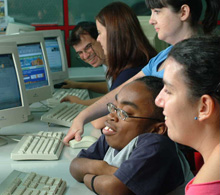

 Inclusion and Accessibility
Inclusion and Accessibility Inclusion and Accessibility
 The development of Information and Communication Technologies (ICT), especially in the last decades of the 20th century, and their mass availability for use by the population have led to a major shift in economic and social activities, impacting on citizens’ quality of life and companies’ competitiveness and productivity.In this context,ICT access and user skills are currently a differentiating factor of major importance for social opportunities. Additionally, ICTs are a powerful tool for social inclusion that open new horizons in terms of inclusion policies and schemes. In this way, these technologies can and should be both a factor for social cohesion and in fighting exclusion.
The development of Information and Communication Technologies (ICT), especially in the last decades of the 20th century, and their mass availability for use by the population have led to a major shift in economic and social activities, impacting on citizens’ quality of life and companies’ competitiveness and productivity.In this context,ICT access and user skills are currently a differentiating factor of major importance for social opportunities. Additionally, ICTs are a powerful tool for social inclusion that open new horizons in terms of inclusion policies and schemes. In this way, these technologies can and should be both a factor for social cohesion and in fighting exclusion.
According to EUROSTAT - IS, Internet penetration among the Portuguese population was 40% in the 1st quarter of 2007, putting it in 20th place in the EU27, above only Italy, Cyprus, Greece, Bulgaria and Romania.
However, Internet penetration was 81% among the population with secondary schooling, the 5th highest in the EU27, hot on the heels of the Netherlands, Denmark, Luxemburg and France and tied with Finland and Sweden. Internet penetration for the population with higher education schooling was 97% – the 7th highest in the EU27, close behind the four aforementioned countries and Finland, the United Kingdom and neck and neck with Slovenia.
In accordance with the Action Programme Connecting Portugal, Inclusion and Accessibility projects are aimed at promoting social inclusion, namely through guaranteeing:
- Use of ICT by info-excluded groups;
- Social inclusion of immigrants and other excluded social groups or those at risk of exclusion;
- Accessibility for citizens with special needs;
- Densification of community centres with Internet access providing support for users with constant updates and improvements;
- Minimising digital barriers created in content conception with particular attention given to content made available by the Public Administration, harnessing the Internet as a key tool for disabled people’s inclusion and participation in society.
The following are examples of outputs and actions to be carried out:
- Doubling the Internet Spaces network in municipalities, enabling free public broadband access, accompanied by specialised monitors and conditions for users with special needs;
- Creating a public Citizenship Internet service, ensuring free access to public services and services of public interest available online, which should cover all basic services before the end of the legislature;
- Developing a social inclusion platform aimed at the 25 to 54 year old population with basic skills or lower, providing help staff, in particular in residential areas in urban centres;
- Developing a social inclusion platform aimed at the elderly, with specific schemes in centres for the elderly;
- Developing a multi-institutional platform to fight info-exclusion and to facilitate the integration of immigrants and other social groups via the use of ICT, improving the network of community centres with Internet access to support these groups;
- Ensuring ICT accessibility for citizens with special needs, namely via the public Internet spaces network;
- Promoting ICT research, dissemination and training for citizens with special needs.
Last updated (18/01/2010)
